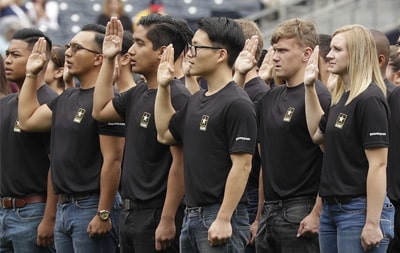
The Fourth Circuit Court of Appeals ruled last week that the federal ban on handgun sales to those aged 18 to 20 is unconstitutional.
The Second Amendment Foundation immediately called it a “monumental victory for Second Amendment rights.”
Constitutional protections do not begin at age 21.
Writing for the majority, Judge Julius N. Richardson noted that a historical reading of the text and structure of the Constitution clearly shows that 18- to 20-year olds are protected by the Bill of Rights.
“Virtually every other constitutional right applies whatever the age. And the Second Amendment is no different.”
The 1968 federal law banning the sale of handguns to young adults under the age of 21 was therefore struck down by the Richmond-based appeals court.
The 2-1 decision came in the case brought by Natalia Marshall, who was 18 when she wanted to purchase a handgun to protect herself from her abusive ex-boyfriend.
She lived in a rural area and needed a firearm to defend herself, but the firearms dealer refused to sell one to her due to the federal law.
Richardson, an appointee of former President Donald Trump, conceded that “in the law, a line must sometimes be drawn.”
But he then noted that the government must have a legitimate reason for denying constitutional rights until a certain age. These protections, he asserted, vest no later than 18.
Congress, he said, “may not restrict the rights of an entire group of law-abiding adults because a minuscule portion of that group commits a disproportionate amount of gun violence.”
He added that 1960s lawmakers used flawed data to justify the legal change.
Despite the need to combat violent crime, Richardson declared that the Fourth Circuit will not apply second-class status to either the Second Amendment or 18-to-20-year-olds.
Second Amendment Foundation (SAF) founder and Executive Vice President Alan M. Gottlieb concurred with the court’s findings. He echoed the panel’s recognition that the U.S. sends 18- to 20-year-old men and women into combat with “the most sophisticated weaponry.”
Where is the logic and reasoning, Gottlieb questioned, in prohibiting law-abiding adults “from purchasing a handgun from a federally licensed dealer for their own protection at home?”
The SAF has similar cases pending in Illinois, Louisiana, Pennsylvania, Washington, California, Minnesota, and other states.
Richardson was joined by Judge G. Stephen Agee, a George W. Bush appointee, in the majority opinion for the Fourth Circuit. The decision affects only states within the circuit, and these include Virginia, West Virginia, Maryland, and North and South Carolina.
The dissenting voice came from Judge James Wynn Jr, an appointee of Barack Obama. He wrote that the Second Amendment is indeed an “exceptional right” but that the majority erred in their ruling nonetheless.
Wynn believes that the amendment is singularly different from others in the Bill of Rights because it is “capable of causing harm.” He argued that the right to keep and bear arms is not “oppressed or imperiled,” and that the courts should allow lawmakers to decide how it applies to American citizens.
The Biden Justice Department will almost certainly appeal the decision.
The Constitution is not vague on rights bestowed on the public. Richardson is correct in his assertion that precious protections are bestowed upon all at 18 years of age. And while there are lines to be drawn and exceptions to be made, they must not be arbitrary and haphazard.
Rather, the government must have an overwhelmingly compelling reason to deny protections of the Bill of Rights to law-abiding citizens.
These actions must be the exception rather than the rule, or the Constitution loses its meaning and value.
In this instance, the courts stood up for what is right. It will be quite interesting to follow the progress of similar suits in other courts, and whether the judges there will have similar courage to stand up to Washington and the fierce anti-gun lobby.
